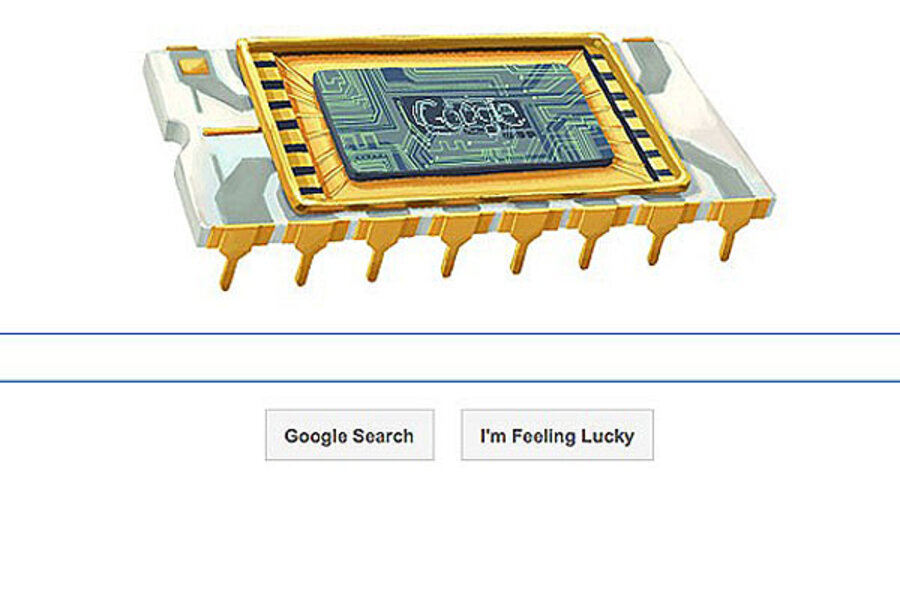Robert Noyce: Why Steve Jobs idolized Noyce
Robert Noyce was the co-inventor of the microchip, co-founder of Fairchild Semiconductors and Intel Corp.
For these contributions alone, his 84th birthday is worthy of a Google doodle homage. But Noyce was also a father figure, a mentor to many key Silicon Valley startups - including Apple computer co-founder Steve Jobs.
Here's what Steve Jobs told Leslie Berlin, author of "The Man Behind the Microchip" about Noyce:
"Bob Noyce took me under his wing," Apple Computer founder Steve Jobs explains. "I was young, in my twenties. He was in his early fifties. He tried to give me the lay of the land, give me a perspective that I could only partially understand." Jobs continues, "You can't really understand what is going on now unless you understand what came before."
Ms. Berlin writes that Jobs was one of many Silicon Valley entrepreneurs mentored by Noyce after he left daily management at Intel in 1975. He served on the boards of half a dozen startup companies, and invested in many more.
In a 1990 WGBH NOVA mini-series "The Machine That Changed the World," the interviewer notes that Robert Noyce took up hang gliding at age 40. He was an inventor and risk taker. To which Jobs replies:
"My observation is that the doers are the major thinkers. The people that really create the things that change this industry are both the thinker and doer in one person. And if we really go back and we examine, you know did Leonardo have a guy off to the side that was thinking five years out in the future what he would paint or the technology he would use to paint it, of course not. Leonardo was the artist but he also mixed all his own paints. He also was a fairly good chemist. He knew about pigments. [And] knew about human anatomy. And [combining] all of those skills together, the art and the science, the thinking and the doing, was what resulted in the exceptional result."
In a recent blog about Steve Jobs, Nancy Linde says that it was Noyce that got Jobs to participate in the NOVA mini-series. Jobs initially declined to be interviewed, but Linde says "Steve Jobs revered Bob Noyce, and a one-paragraph letter from Noyce changed Jobs' "no" into a "yes,"
Noyce and Jobs also shared some management similarities. Noyce, for example, is described by Leslie Berlin this way:
"Noyce was forever pushing people to take their own ideas beyond where they believed they could go. "That's all you've got?" he'd ask. "Have you thought about . . . " An exchange of this sort left Noyce's colleagues and employees feeling as though his blue eyes had bored right through their skulls to discover some potential buried inside themselves or their ideas that they had not known existed. It was exhilarating and a bit frightening. "If you weren't intimidated by Bob Noyce, you'd never be intimidated by anybody," recalls Jim Lafferty, Noyce's friend and fellow pilot."
Similarly, Walter Isaacson's new biography of Jobs, makes much of Jobs' "reality distortion" management style. Jobs would regularly and, often disparagingly, challenge Apple employees and push them beyond what they thought was possible.
Intel Corp. was founded by Noyce, Gordon Moore, and Andrew Grove. Steve Jobs idolized Andrew Grove, too, according to Isaacson's biography about Jobs. When he was considering whether to return to be CEO of Apple or not, Jobs called Grove for advice – which was seven years after Noyce had passed on.
Thenextweb.com put it this way:
"According to the account that Jobs gave Isaacson, the call to Grove was 8am on a Saturday morning, but the content of the call was very much the same. Grove stopped Jobs’ long-winded list of pros and cons of returning to Apple and told him “Steve, I don’t give a [bleep] about Apple.”
Jobs said he was stunned and realized that he “did give a [bleep] about Apple. I started it and it is a good thing to have in the world.”
And that is how Jobs finally made the decision in 1997 to come back as CEO on a ‘temporary’ basis that would last until a month before his death in October, 2011. In 2005, Apple made the transition to Intel processors, which it still uses today."





